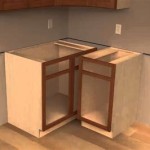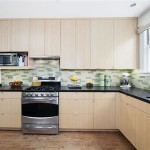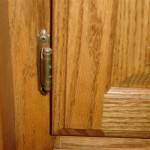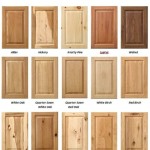How To Clean Kitchen Cabinet Doors
Kitchen cabinets are a focal point in any kitchen, and maintaining their cleanliness contributes significantly to the overall hygiene and aesthetic appeal of the space. Regular cleaning prevents grease, grime, and food splatters from building up and causing permanent damage. This guide outlines effective methods for cleaning various types of kitchen cabinet doors.
Before beginning the cleaning process, it's crucial to identify the cabinet door material. Different materials require specific cleaning solutions to prevent damage. Common kitchen cabinet door materials include wood, laminate, painted wood, and metal. Knowing the material allows for the selection of appropriate cleaning agents and techniques.
Gathering the necessary cleaning supplies beforehand streamlines the process. Typically, these include soft cleaning cloths, a bucket of warm water, mild dish soap, a spray bottle, baking soda, white vinegar, and a toothbrush for hard-to-reach areas. For tougher stains, specialized cleaning products designed for specific cabinet materials might be necessary. Always test any new cleaning product on an inconspicuous area of the cabinet before widespread application.
For cleaning wood kitchen cabinets, a gentle approach is recommended. Mix a small amount of mild dish soap with warm water in a bucket. Dampen a soft cloth with the solution, ensuring it's not overly wet. Excessive moisture can damage wood. Wipe down the cabinet doors thoroughly, following the wood grain. Immediately afterward, dry the cabinets completely with a clean, dry cloth to prevent watermarks.
Laminate kitchen cabinets are relatively easy to clean due to their durable surface. Similar to wood cabinets, a solution of mild dish soap and warm water is effective. Wipe down the doors with a soft cloth dampened with the solution. Avoid abrasive cleaners and scouring pads, as they can scratch the laminate surface. Rinse with a clean, damp cloth and dry thoroughly.
Painted wood cabinets require careful cleaning to avoid damaging the paint finish. Before cleaning, dust the doors thoroughly to remove loose particles. A mixture of mild dish soap and warm water is generally suitable. Apply the solution with a soft cloth, working in small sections. Rinse with a clean, damp cloth and dry immediately to prevent streaking. For stubborn stains, a paste of baking soda and water can be applied and gently rubbed in before rinsing.
Metal kitchen cabinets can often be cleaned effectively with a simple solution of warm water and dish soap. Apply the solution with a soft cloth or sponge, wiping down the surfaces thoroughly. For tougher grease or grime buildup, a degreasing cleaner specifically formulated for metal can be used. Rinse with clean water and dry thoroughly to prevent water spots.
Dealing with greasy kitchen cabinets requires a slightly different approach. A mixture of baking soda and water can create a paste effective in cutting through grease. Apply the paste to greasy areas and let it sit for a few minutes before wiping it away with a damp cloth. Alternatively, a solution of white vinegar and water can also be used as a natural degreaser. Spray the solution onto the greasy areas, let it sit for a few minutes, and then wipe clean with a damp cloth.
Sticky residue on kitchen cabinets can be removed using a variety of methods. A solution of equal parts water and white vinegar can be effective in dissolving sticky substances. Apply the solution to the affected area, let it sit for a few minutes, and then wipe clean. For stubborn residue, a commercial adhesive remover can be used, but it's important to test it in an inconspicuous area first to ensure it doesn't damage the cabinet finish.
Maintaining clean kitchen cabinets necessitates regular cleaning. Wiping down the doors with a damp cloth after each meal can prevent buildup of grease and grime. A more thorough cleaning, as described above, should be performed at least once a week. This regular maintenance will keep the cabinets looking their best and prolong their lifespan.
Preventing future buildup on kitchen cabinets involves consistent cleaning practices and adopting preventative measures. Regularly wiping down spills and splatters as they occur can significantly reduce the accumulation of grime. Using a range hood while cooking can minimize airborne grease particles from settling on cabinet surfaces. Additionally, placing protective liners on cabinet shelves can prevent spills from soaking into the wood or laminate.
Addressing specific stains on kitchen cabinets often requires tailored solutions. For water stains on wood cabinets, a mixture of equal parts white vinegar and olive oil can be applied to the affected area. Gently rub the mixture in with a soft cloth and then buff with a clean, dry cloth. Ink stains can sometimes be removed with rubbing alcohol applied to a cotton ball. Always test any stain removal technique in an inconspicuous area first.
Maintaining the cleanliness of kitchen cabinet hardware enhances the overall appearance. Handles and knobs can accumulate grease and grime over time. Remove them, if possible, and soak them in warm soapy water. Scrub gently with a toothbrush to remove stubborn dirt. Dry thoroughly before reattaching.

How To Clean Sticky Grease Off Kitchen Cabinets Ovenclean

How To Clean Kitchen Cabinet Doors

3 Ways To Clean Kitchen Cabinets Wikihow Life
Here S How To Clean Kitchen Cabinets Until They Shine

How To Remove Grease From Kitchen Cabinets 3 Methods Bob Vila

How To Clean Kitchen Cabinets 9 Basics Bob Vila

How To Clean Shaker Cabinets

3 Ways To Clean Kitchen Cabinets Wikihow Life

How To Clean Kitchen Cabinets Thoroughly Oppein

How To Clean Kitchen Cabinet Doors Detailed Guide 2024
Related Posts








